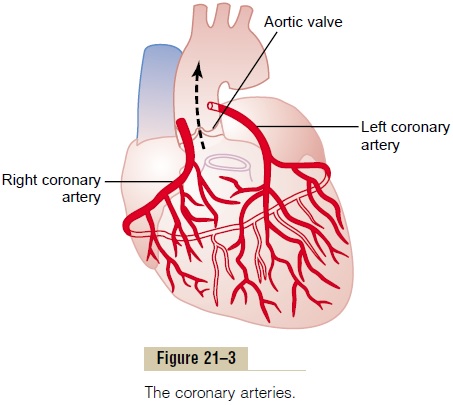Chapter: Medical Physiology: Muscle Blood Flow and Cardiac Output During Exercise; the Coronary Circulation and schemic Heart Disease
Pain in Coronary Heart Disease
Pain in Coronary Heart Disease
Normally, a person cannot “feel” his or her heart, but ischemic cardiac muscle often does cause pain sensa-tion—sometimes severe pain. Exactly what causes this pain is not known, but it is believed that ischemia causes the muscle to release acidic substances, such as lactic acid, or other pain-promoting products, such as histamine, kinins, or cellular proteolytic enzymes, that are not removed rapidly enough by the slowly moving coronary blood flow. The high concentrations of these abnormal products then stimulate pain nerve endings in the cardiac muscle, sending pain impulses through sensory afferent nerve fibers into the central nervous system.
Angina Pectoris
In most people who develop progressive constriction of their coronary arteries, cardiac pain, called angina pectoris, begins to appear whenever the load on theheart becomes too great in relation to the available coronary blood flow. This pain is usually felt beneath the upper sternum over the heart, and in addition it is often referred to distant surface areas of the body, most commonly to the left armand left shoulder but also frequently to the neck and even to the side of theface. The reason for this distribution of pain is that theheart originates during embryonic life in the neck, as do the arms. Therefore, both the heart and these surface areas of the body receive pain nerve fibers from the same spinal cord segments.
Most people who have chronic angina pectoris feel pain when they exercise or when they experience emotions that increase metabolism of the heart or temporarily constrict the coronary vessels because of sympathetic vasoconstrictor nerve signals. The pain usually lasts for only a few minutes. However, some patients have such severe and lasting ischemia that the pain is present all the time. The pain is frequently described as hot, pressing, and constricting; it is of such quality that it usually makes the patient stop all unnec-essary body activity and come to a complete state of rest.
Treatment with Drugs. Several vasodilator drugs, whenadministered during an acute anginal attack, can often give immediate relief from the pain. Commonly used vasodilators are nitroglycerin and other nitratedrugs.
A second class of drugs that are used for prolonged treatment of angina pectoris is the beta blockers, such as propranolol. These drugs block sympathetic beta adrenergic receptors, which prevents sympathetic enhancement of heart rate and cardiac metabolism during exercise or emotional episodes. Therefore, therapy with a beta blocker decreases the need of the heart for extra metabolic oxygen during stressful conditions. For obvious reasons, this can also reduce the number of anginal attacks as well as their severity.


Related Topics